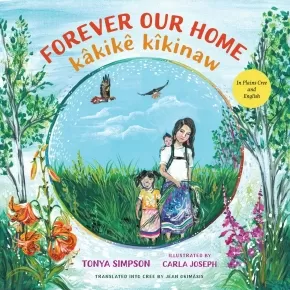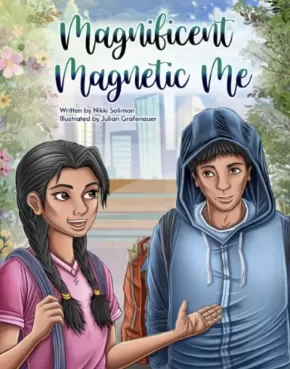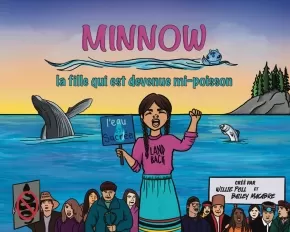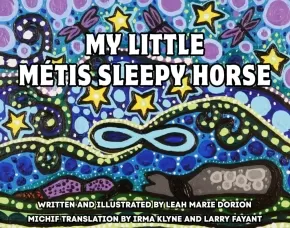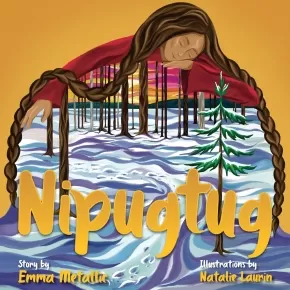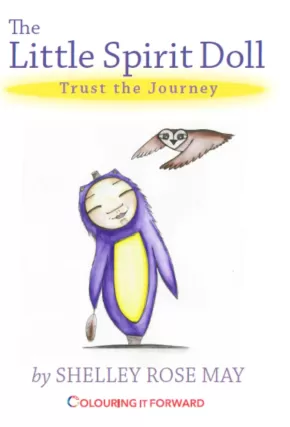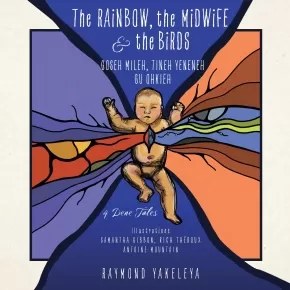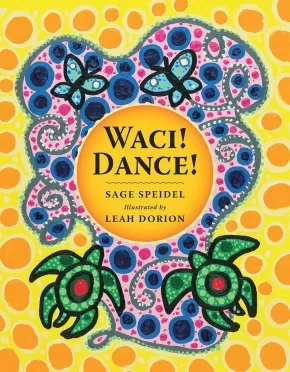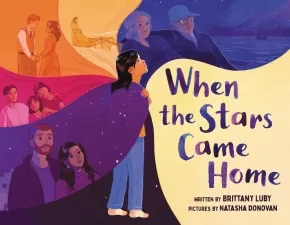
Métis
91
-
105
of
225 Results;
Sort By
Go To
of 15
Forever Our Home / kâkikê kîkinaw
$21.95
Artists:
Format:
Hardcover
Text Content Territories:
Indigenous Canadian; First Nations; Cree (Nehiyawak); Plains Cree; Pasqua First Nation;
Grade Levels: Preschool; Kindergarten;
ISBN / Barcode: 9781459837584
Synopsis:
Synopsis:
A lullaby of reconciliation and reclamation, celebrating the ancestral relationship between Indigenous children and the land that is forever their home.
Under glowing morning sun and silvery winter moon, from speckled frogs croaking in spring to summer fields painted with fireweed, this meditative lullaby introduces little ones to the plants and animals of the Prairies and the Plains. Featuring stunning artwork by celebrated artist Carla Joseph, Forever Our Home is a beautiful and gentle song about our spiritual connection to the land.
Reviews
A tender hymn to the prairie in all seasons...Uplifting and joyous." — Kirkus Reviews
Educator Information
Recommended for ages 3 to 5.
Written in both Plains Cree and English and featuring stunning artwork by celebrated artist Carla Joseph, Forever Our Home / kâkikê kîkinaw is a beautiful and gentle song about our spiritual connection to the land.
Find the English version here: Forever Our Home
Additional Information
32 pages | 9.00" x 9.00" | Hardcover
Maggie Lou Meets Her Match
$14.99
Format:
Paperback
Text Content Territories:
Indigenous Canadian; Métis;
ISBN / Barcode: 9781773067742
Synopsis:
Synopsis:
In this sequel to Maggie Lou, Firefox, the irrepressible Maggie Lou acquires a new cousin, and a horse - both of whom have minds of their own.
When Uncle Bobby gets married, Maggie Lou suddenly finds herself with a new cousin, Rosie. Rosie is the same age as Maggie. She also has a fabulous head of curls, although hers are red. And Rosie knows everything about horses and riding - something Maggie Lou has longed to do.
A rivalry sparks between the girls from the start at Uncle Bobby and Aunt Bonnie's wedding, which features an all-you-can-eat dessert table, as well as lots of energetic dancing. On Rosie's horse farm, Maggie experiences her share of humiliations as she learns how to ride on a pony so short that her feet can touch the ground.
Eventually the cousins become allies and wreak some hair-raising mischief, including a secret midnight horseback ride. And in the end they are joined by friends and family to train, hilariously, for the famous Otipîm'sowak Race - a Métis voyageur relay - carrying on a family tradition.
Throughout it all, Maggie remains stubborn and enthusiastic, as she navigates the new challenges of defeat, rivalry and family change.
Reviews
"A high-energy love letter to rambunctious girls, big families, and Métis culture." — Kirkus Reviews, June 2025
"Full of hilarious high jinks yet bursting with heart ... This book shines with realistic sibling relationships, funny dialogue, strong intergenerational bonds, and a steadfast connection to community and culture."— Booklist, July 2025
Educator & Series Information
Recommended for ages 9 to 12.
This book is the second book in the Maggie Lou series.
Key Text Features: chapters; character drawings; dialogue; glossary; illustrations.
Additional Information
228 pages | 5.00" x 7.50" | b&w illustrations | Paperback
Maggie Lou, Firefox
$14.99
Format:
Paperback
Text Content Territories:
Indigenous Canadian; Métis;
ISBN / Barcode: 9781773068817
Synopsis:
Synopsis:
Maggie Lou's grandpa doesn't call her Firefox for nothing. She's always finding ways to make life more interesting - even if this means getting into big trouble.
"Keep taking up space," Maggie Lou's mother says. You're only making room for the girls behind you."
When her grandfather Moshôm finally agrees to teach her how to box, she decides that the rank odors, endless drills and teasing won't stop her from wearing a tutu to the gym. Joining her father's construction crew uncovers a surprising talent - besides learning how to use a broom - and a great source of scrap wood to build a canine hotel for her dogs. And when she turns thirteen, she figures out an ingenious way to make some smokin' good camouflage to wear on her first deer hunt, where she joins a long family tradition.
Through it all she is surrounded by her big extended gumbo soup of a family, pestered by annoying younger siblings, and gently guided by her strong female relatives - her mother, her kokhom and her ultra-cool cousin Jayda. "Keep taking up space," Maggie's mother says. "You're only making room for the girls behind you."
A heroine for today, Maggie Lou discovers that with hard work and perseverance she can gain valuable new skills, without losing one iota of her irrepressible spirit.
Reviews
"Métis author Bowes weaves cultural elements, including Northern Michif words, into this charming story that skillfully captures sweetly hilarious and loving everyday moments. Black-and-white illustrations enhance the text. An amusing story showcasing Métis humor at its finest." - Kirkus, STARRED REVEIW
Educator & Series Information
Recommended for ages 9 to 12.
This is the first book in the Maggie Lou series.
Key Text Features: author's note, biographical note, glossary, chapters, dialogue, epigraph, illustrations.
Includes some Northern Michif words and a glossary.
Additional Information
220 pages | 5.00" x 7.50" | b&w illustrations | Paperback
Magnificent Magnetic Me
$19.99
Artists:
Format:
Paperback
Text Content Territories:
Indigenous Canadian;
ISBN / Barcode: 9781990297434
Synopsis:
Synopsis:
Métis writer and educator Nikki Soliman walks children through the importance of mental health and wellness in Magnificent Magnetic Me. This book examines the importance of embracing the tools needed to stay positive. It teaches about the power of thoughts and words and the energy we attract.
Educator Information
Recommended for grades 5 to 8.
Additional Information
32 Pages | Paperback
Minnow: la fille qui est devenue mi-poisson
$16.99
Artists:
Format:
Paperback
Text Content Territories:
Indigenous Canadian;
ISBN / Barcode: 9781778540202
Synopsis:
Synopsis:
Minnow, une jeune autochtone, protectrice des eaux, entreprend un voyage sous l'eau ou elle en apprend de notre famille qui vit dans l'ocean. Quand elle retourne a la surface, elle rassemble sa communaute pour aider a apporter des changements. Cette histoire est racontee en rimes lyriques et aide les enfants a mieux respecter les gens qui protegent les eaux et les terres autochtones, l'environnement et le monde qui les entoure. Elle aide a faire decouvrir l'activisme aux enfants tot dans leur vie.
Educator Information
Recommended for ages 6 to 10.
A teacher lesson plan for this title is available: Minnow: la fille qui est devenue mi-poisson plan de cours
This book is available in English: Minnow: The Girl Who Became Part Fish
Additional Information
44 pages | 9.94" x 6.34" | Paperback
Minnow: The Girl Who Became Part Fish
$16.99
Artists:
Format:
Paperback
Text Content Territories:
Indigenous Canadian;
ISBN / Barcode: 9781778540097
Synopsis:
Synopsis:
A young Indigenous water protector named Minnow goes on an underwater journey; learning from our ocean-living relatives. When she returns to the surface, she gathers her community to help make a change. This story is told in lyrical rhyme and helps children gain a better respect for Indigenous water and land protectors, the environment, and world around them, and helps show children activism at an early age.
Educator Information
Recommended for ages 8 to 10.
Find a teacher lesson plan here: Minnow: The Girl Who Became Part Fish Teacher Lesson Plan
This book is available in French: Minnow: la fille qui est devenue mi-poisson
Additional Information
48 pages | 10.83" x 8.58" | Paperback
My Little Métis Sleepy Horse (BB)
$17.50
Artists:
Format:
Board Book
Text Content Territories:
Indigenous Canadian; Métis;
Grade Levels: Preschool;
ISBN / Barcode: 9781988011318
Synopsis:
Synopsis:
My Little Métis Sleepy Horse is a bedtime story in a board book format that is best read aloud by adult caregivers to small children. Horse stories are an important theme in Métis oral history and telling horse-themed stories can help reconnect children to their Métis cultural roots on the high plains. Award-winning, bestselling author, and artist, Leah Marie Dorion captures our connection to horses through her vivid paintings.
Educator Information
Dual-language: English and Michif
Michif Translators: Irma Klyne and Larry Fayant
Additional Information
24 Pages | 5.5" x 7" | Board Book
Nipugtug
$18.00
Artists:
Format:
Paperback
Text Content Territories:
Indigenous Canadian; First Nations; Mi'kmaq; Listuguj Mi'gmaq First Nation;
ISBN / Barcode: 9781928120414
Synopsis:
Synopsis:
Set in the community of Listuguj, Gespe'gewa'gi, Nipugtug follows the journey of A'le's (Mi'gmaw for Alice), a young Mi'gmaw woman, snowshoeing through the forest. There, she meets animals, Wapus (Rabbit), Wowgwis (Fox), Tia'm (Moose), Ga'qaquj (Crow) and trees, Masgwi (Birch), Qasgusi (Cedar) who guide her through both challenging and nourishing emotions of learning her Mi'gmaw language. Grounded in her relationship with the territory, A'le's navigates memories of her language that cling to realities within and beyond her life.
Educator Information
Recommended for ages 7 to 11.
Additional Information
21 pages | 9.00" x 9.00" | 4 Illustrations | Paperback
Nutshimit: In the Woods
$22.99
Artists:
Format:
Hardcover
Text Content Territories:
Indigenous Canadian; First Nations; Innu (Montagnais-Naskapi); Ekuanitshit; Inuit; Métis;
ISBN / Barcode: 9781039701809
Synopsis:
Synopsis:
In this immersive first-person account, Innu author Melissa Mollen Dupuis teams up with award-winning author and illustrator Elise Gravel to take readers on a journey through Innu culture, from creation legends to life today.
The Innu word Nutshimit signifies the physical and social space to practice traditional activities and language. Join author Melissa Mollen Dupuis on a guided walk deep through the forest to learn some of the rich culture of the Innu people.
Readers will discover the importance of natural world and learn a few Innu words along the way. Thoughtfully brought to life by Elise Gravel’s signature comic style illustrations, Melissa’s colloquial narrative and anecdotes detailing her lived experiences offer a deeply personal look at Innu life.
Educator Information
Recommended for ages 6 to 8.
Children learn Innu nature vocabulary through anecdotes from author’s lived experiences.
Populated with Elise Gravel’s hilarious characters and plenty of fun details.
This book is available in French: Nutshimit: Un bain de forêt
Find an activity book for this title here: Nutshimit: Activity Book
Additional Information
88 pages | 8.00" x 11.00" | Hardcover
Orange Shirt Day: September 30th: Revised Edition
$32.99
Format:
Hardcover
Text Content Territories:
Indigenous Canadian; First Nations; Inuit; Métis;
ISBN / Barcode: 9781778540141
Synopsis:
Synopsis:
Orange Shirt Day, observed annually on September 30th, is also known as the National Day for Truth and Reconciliation. It is an official day to honour Residential School Survivors and their families, and to remember the children who did not come home. What was initially envisioned as a way to keep the conversations going about all aspects of Residential Schools in Williams Lake and the Cariboo Region of British Columbia, Canada, has now expanded into a movement across Turtle Island and beyond. Orange Shirt Day: September 30th aims to create champions who will walk a path of reconciliation and promote the message that 'Every Child Matters'. This award-winning book explores a number of important topics including the historical, generational, and continual impacts of Residential Schools on Indigenous Peoples, the journey of the Orange Shirt Day movement, and how you can effectively participate in the National Day for Truth and Reconciliation. With end of chapter reflection questions and a series of student art submissions, readers are guided to explore how they, and others, view and participate in Residential School reconciliation.
Awards
- 2021 First Nation Communities Read 2021 Winner
Educator Information
Recommended Ages: 10+
Orange Shirt Day was inspired by the story of a survivor named Phyllis Webstad. When Phyllis was 6 years old she went to residential school for the first time wearing a brand new shiny orange shirt. When she arrived at the school her shirt was taken away and never to be seen again. To Phyllis the colour orange was a symbol that she did not matter. Today she has learned to accept the colour and even have fun with it and now the orange shirt has become a symbol of hope and reconciliation. By wearing an orange shirt on Orange Shirt Day, you make a powerful statement that residential schools were wrong and commit to the concept that EVERY CHILD MATTERS.
The Orange Shirt Society is a non-profit organization with its home in Williams Lake, BC where Orange Shirt Day began in 2013. The society has both Indigenous and non-Indigenous board members, and one of the editors of this book, Phyllis Webstad, is Indigenous. Therefore, the Authentic Indigenous Text label has been applied. It is up to readers to determine if this book is authentic for their purposes.
This is the Revised 2023, 2nd Edition
Additional Information
156 pages | 8.23" x 11.06" | Revised, 2nd Edition
The Little Spirit Doll: Trust the Journey (6 in stock, Out of Print)
$17.00
Artists:
Format:
Paperback
Text Content Territories:
Indigenous Canadian; Métis;
ISBN / Barcode: 23-DF-053-1
Synopsis:
Synopsis:
The little spirit doll is made with clay and wood. The clay was taken without ceremony from her river bank home so the little spirit doll feels traumatized from being ripped from her home and feels that she has no name and no one who loves her. She goes on a journey to heal and with the help of friends and spirit guides, she finds her way.
This 40-page book contains illustrations that are gradually coloured in as the doll heals. It is a great way to teach children about trauma and healing.
Educator Information
Recommended for ages 7 to 10.
Additional Information
40 Pages | 8.5"x 6" | soft cover
The Rainbow, the Midwife, and the Birds: 4 Dene Tales
$29.95
Artists:
Format:
Paperback
Text Content Territories:
Indigenous Canadian; First Nations; Dene;
ISBN / Barcode: 9781988824574
Synopsis:
Synopsis:
The book contains four Dene stories, as told by Raymond Yakeleya. "Flight Through the Rainbow" is about flying through a rainbow in a small plane and experiencing multi-sensations of colour. It also tells the legend of the spider and how its web catches raindrops that create the rainbow. "The Midwife and the Spirit of Life," dedicated to Raymond's Granny Harriet Gladue, is about the birth of babies and bringing their spirits into the world. "The Slingshot and the Songbird" is about a boy's sadness over killing a friendly songbird. "The Medicine Brothers and the Giant Birds" is a tale told to Raymond by his uncle George Blondin about the hazards of giant animals when the world was new.
The book also contains Dene language translation of terms from the book.
Educator & Series Information
This book is recommended for ages 8 to 12.
This book is part of the Indigenous Spirit of Nature series.
Additional Information
48 pages | 8.50" x 8.50" | Paperback
Tiger Lily and the Secret Treasure of Neverland
$22.99
Format:
Hardcover
Text Content Territories:
Indigenous;
ISBN / Barcode: 9781368080460
Synopsis:
Synopsis:
Tiger Lily and her community, the Indigenous people of Neverland, possess a unique ability: they can choose to grow up. But for now, Tiger Lily is enjoying being thirteen, spending time with her grandmother and exploring alongside her horse and her friends.
Then Tiger Lily uncovers a plot by two of Captain Hook’s pirates, who are searching for a mysterious, powerful treasure. Determined to protect Neverland, Tiger Lily sets out on a very grown-up mission: find the treasure first, and keep it out of the pirates’ reckless hands.
As her journey takes her from Mermaid Lagoon to the Lost Boys’ secret fort and beyond, Tiger Lily will need to become the brave leader she has always wanted to be. Can she save her home and people she loves before it’s too late?
Set in the world of Disney+’s upcoming live-action film Peter Pan & Wendy, this original story from acclaimed author Cherie Dimaline weaves a tale of Tiger Lily as you’ve never seen her before.
Educator Information
Recommended for ages 8 to 12.
Additional Information
288 pages | 5.50" x 8.25" | Hardcover
Waci! Dance! (1 in stock, in Reprint)
$23.95
Artists:
Format:
Hardcover
Text Content Territories:
Indigenous American; Native American; Sioux; Lakota; Hunkpapa; Indigenous Canadian; First Nations; Cree (Nehiyawak); Plains Cree; Beardy's and Okemasis' Cree Nation;
ISBN / Barcode: 9780889957275
Synopsis:
Synopsis:
A mother — the author of this story — shares Lakota cultural experiences with her daughter, introducing her to waci (dance) as a way to celebrate life. Wacipi (powwow), where the dancing occurs, is a setting for Indigenous song, dance, regalia, food and crafts.
A warm, family story for all ages, Waci! Dance! visually embraces the joy of being together and caring for each other. (A glossary and author's note are included.)
Educator Information
Recommended for ages 4 to 9.
Additional Information
24 pages | 9.00" x 10.00" | Hardcover
When the Stars Came Home
$24.99
Artists:
Format:
Hardcover
Text Content Territories:
Indigenous Canadian; First Nations; Anishinaabeg;
ISBN / Barcode: 9780316592499
Synopsis:
Synopsis:
A heartwarming book from creators of Indigenous and Métis descent about the power of story and tradition to help navigate change
How does a strange new place become home?
When Ojiig moves to the city with his family, he misses everything they left behind. Most of all, he misses the sparkling night sky. Without the stars watching over him, he feels lost.
His parents try to help, but nothing seems to work. Not glow-in-the-dark sticker stars, not a star-shaped nightlight. But then they have a new idea for how to make Ojiig feel better — a special quilt stitched through with family stories that will wrap Ojiig in the warmth of knowing who he is and where he came from. Join this irresistible family as they discover the power of story and tradition to make a new place feel like home.
Reviews
"Luby (Anishinaabe) and Donovan (Métis) have created a story of identity that is grounded in a specific community with universal themes that will appeal to many readers…useful for classes engaging in discussions about cultural identity, migration, and remaining connected to one’s culture…Highly recommended.”—School Library Journal, starred review
“Luby’s lyrical text and Donovan’s vibrant…illustrations combine to powerfully convey universal themes about change and the strength of family.”—Horn Book, starred review
Educator Information
Recommended for ages 4 to 8.
Additional Information
40 pages | 11.00" x 8.50" | Hardcover
Sort By
Go To
of 15

